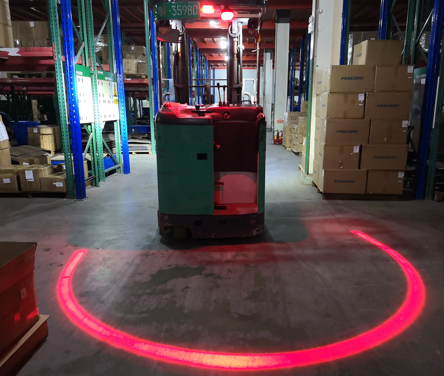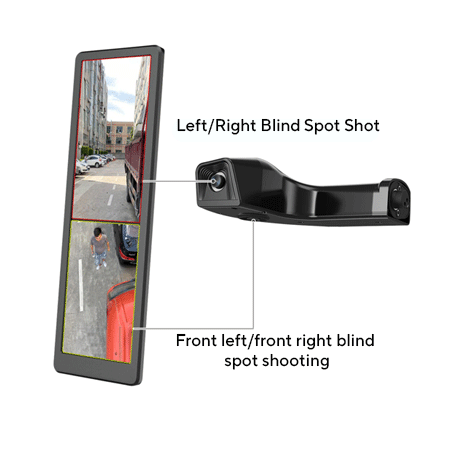Preventing Accidents and Reducing Risks in Agriculture
Accidents involving agricultural vehicles can have serious consequences, including injury, damage to property, and even loss of life. Safety cameras and lighting are tools that you can install to help reduce these risks.
Agricultural vehicles usually have blind spots—areas the driver can’t see from the cab. These blind spots pose a danger, especially when reversing, working in tight spaces or driving on public roads. Safety cameras provide the driver with a clear and real-time view of hidden areas, enabling them to detect people, animals, or objects. This reduces the chance of accidents, collisions, and injuries.
Safety lighting improves visibility during low-light conditions. A lot of agricultural work happens during early mornings, late evenings, or even overnight. Without adequate lighting, it becomes difficult to see obstacles, other vehicles, or workers. Bright headlights, work lights, and flashing beacons ensure that the vehicle is clearly visible from a distance, reducing the chances of a collision. Flashing lights also alert other road users that a slow-moving vehicle is present, enhancing road safety for everyone.
Protecting Workers and the Public
Agricultural work environments can be hazardous, particularly when large vehicles are being driven. Safety cameras and lighting provide protection for both farmworkers and the general public.
Farmworkers often operate machinery near moving vehicles. Safety cameras allow vehicle operators to monitor their surroundings and check for nearby people. This is especially important during work like loading and unloading crops, attaching machinery, or reversing. By having a clear view of their environment, drivers can avoid accidental injuries and equipment damage. Many modern safety camera systems can record video footage. In the event of an accident, these recordings provide valuable evidence to determine what went wrong and to improve safety practices in the future. The evidence can help protect you in a legal case.
When agricultural vehicles travel on public roads, proper safety lighting is important to protect other road users. Large machinery can be slow-moving and difficult to manoeuvre, posing risks to faster-moving vehicles. Bright, well-positioned lights make agricultural vehicles easier to see in all weather conditions, including fog, rain, and at night. This visibility reduces the chances of collisions and enhances overall road safety. Compliance with road safety regulations regarding vehicle lighting also prevents legal issues and potential fines.

Enhancing Operational Efficiency and Productivity
Beyond improving safety, the use of safety cameras and lighting also increases operational efficiency. Modern farming relies on precision and speed, and these technologies contribute significantly to smoother operations.
Safety cameras help in performing complex tasks with greater accuracy. For example, they assist drivers in aligning trailers, attaching machinery, and monitoring the loading process. This reduces errors and prevents damage to both equipment and crops. Cameras also provide visibility when navigating through challenging terrain or confined spaces, which minimises the risk of accidents and delays. A magnetic wireless camera can help when using multiple attachments intermittently.
Safety lighting allows agricultural work to continue after sunset or in low-visibility conditions. This is particularly important during periods like planting and harvesting, where time and light is limited, and the workload is high. With proper lighting, farmworkers can safely extend their working hours without compromising safety standards. This increased productivity helps farms to meet deadlines, manage large-scale operations, and respond to light and weather-related time pressures.
Compliance with Legal and Industry Standards
In many countries, there are legal requirements for agricultural vehicles operating on public roads to have appropriate safety lighting and visibility aids. This includes using flashing amber beacons, reflective markings, and head and rear lights. Failure to comply with these regulations can result in fines, legal liability, and increased risk of accidents.
Investing in safety cameras and lighting ensures that agricultural vehicles meet or exceed these legal standards. It also demonstrates a commitment to best practices in workplace safety. By adhering to regulations and maintaining up-to-date safety equipment, farms protect their workers, reduce liability, and foster a culture of safety and responsibility.

Long-Term Cost Savings
While the initial investment in safety cameras and lighting may seem a lot, the long-term benefits far outweigh the costs. Preventing accidents reduces expenses related to equipment repairs, and insurance claims. Improved efficiency leads to faster project completion and less downtime, resulting in higher productivity and profitability.
Accident investigations and legal proceedings can be expensive and time-consuming. Safety cameras provide visual evidence that can protect farms from false claims and help to resolve disputes quickly. Also demonstrating a commitment to safety can lower insurance premiums, leading to further cost savings.
These technologies play a vital role in preventing accidents, protecting workers and the public, enhancing operational efficiency, and ensuring legal compliance. By investing in safety equipment, farms create a safer working environment, reduce the risk of costly incidents, and improve overall productivity. As agricultural practices continue to evolve, the importance of advanced safety measures cannot be overstated. Prioritising safety today ensures a safer, more efficient future for everyone involved in farming operations.
To see more on safety equipment, visit https://aida-sys.com/products/